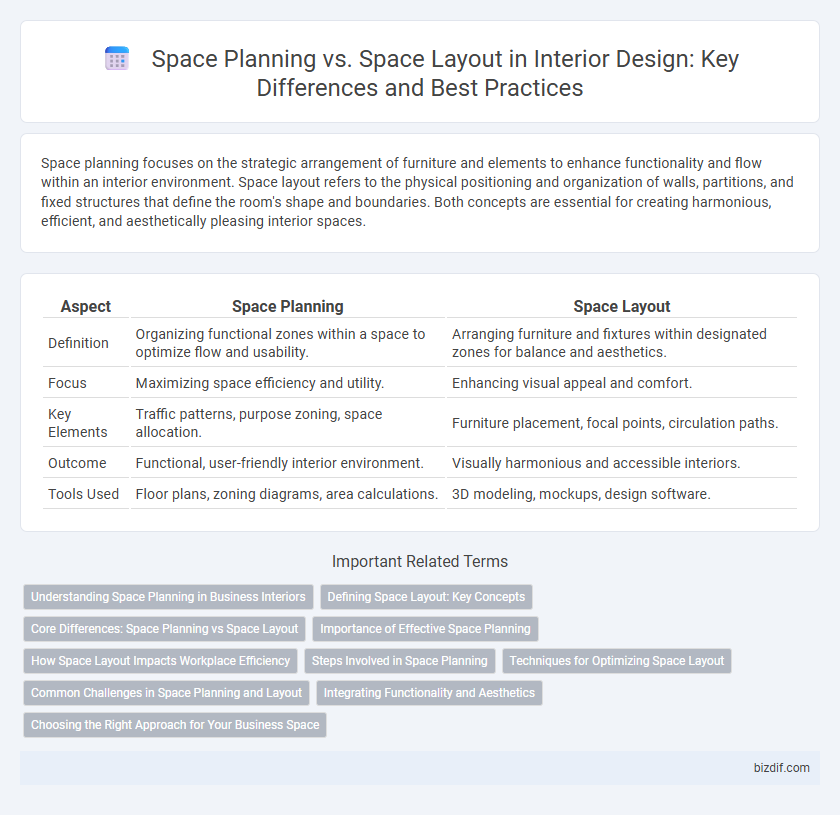Space planning focuses on the strategic arrangement of furniture and elements to enhance functionality and flow within an interior environment. Space layout refers to the physical positioning and organization of walls, partitions, and fixed structures that define the room's shape and boundaries. Both concepts are essential for creating harmonious, efficient, and aesthetically pleasing interior spaces.
Table of Comparison
| Aspect | Space Planning | Space Layout |
|---|---|---|
| Definition | Organizing functional zones within a space to optimize flow and usability. | Arranging furniture and fixtures within designated zones for balance and aesthetics. |
| Focus | Maximizing space efficiency and utility. | Enhancing visual appeal and comfort. |
| Key Elements | Traffic patterns, purpose zoning, space allocation. | Furniture placement, focal points, circulation paths. |
| Outcome | Functional, user-friendly interior environment. | Visually harmonious and accessible interiors. |
| Tools Used | Floor plans, zoning diagrams, area calculations. | 3D modeling, mockups, design software. |
Understanding Space Planning in Business Interiors
Space planning in business interiors involves strategically organizing workspaces to maximize functionality, efficiency, and employee productivity, ensuring optimal use of available square footage. It focuses on aligning spatial design with business needs, considering workflow, accessibility, and collaboration zones to enhance operational effectiveness. Effective space planning integrates furniture placement, circulation paths, and zoning to create an adaptable and comfortable work environment.
Defining Space Layout: Key Concepts
Space layout in interior design defines the precise arrangement of furniture, fixtures, and architectural elements within a room to enhance functionality and aesthetics. It involves detailed considerations such as traffic flow, ergonomic placement, and spatial relationships to optimize user experience. Effective space layout ensures balanced proportions and visual harmony, directly impacting comfort and usability.
Core Differences: Space Planning vs Space Layout
Space planning focuses on the strategic arrangement of functional zones within an interior environment to optimize workflow, accessibility, and usability. Space layout emphasizes the detailed positioning of furniture and fixtures to enhance aesthetic appeal and spatial harmony. The core difference lies in space planning addressing overall spatial organization, while space layout deals with the specific placement of interior elements for user experience.
Importance of Effective Space Planning
Effective space planning maximizes the functionality and flow of interior environments by strategically arranging furniture, fixtures, and circulation paths to suit user needs. Unlike space layout, which focuses on the physical arrangement of elements, space planning integrates spatial relationships with human behavior and usage patterns, enhancing comfort and efficiency. Prioritizing effective space planning leads to optimized room utilization, improved accessibility, and a harmonious balance between aesthetics and practicality.
How Space Layout Impacts Workplace Efficiency
Effective space layout directly influences workplace efficiency by optimizing employee movement, collaboration zones, and furniture placement to enhance workflow. Strategic arrangement of workstations and communal areas reduces unnecessary travel time and minimizes distractions, fostering a productive environment. Proper space layout integrates ergonomics and accessibility, supporting employee well-being and boosting overall operational performance.
Steps Involved in Space Planning
Space planning involves analyzing the functional requirements of a space, measuring dimensions, and creating a scaled floor plan to optimize flow and usability. Key steps include identifying activities, determining space allocation, and selecting appropriate furniture and fixtures to enhance comfort and efficiency. This process ensures that the layout supports both aesthetic appeal and practical functionality, distinct from the broader concept of space layout which focuses on arrangement.
Techniques for Optimizing Space Layout
Space planning involves analyzing and organizing architectural elements to maximize functionality, while space layout focuses on arranging furniture and fixtures to enhance flow and usability. Techniques for optimizing space layout include zoning areas by activity, utilizing modular and multi-functional furniture, and maintaining clear circulation paths to improve spatial efficiency. Incorporating natural light and strategic storage solutions further refines the layout for balanced aesthetics and practicality.
Common Challenges in Space Planning and Layout
Space planning and space layout often face challenges such as inefficient use of square footage, poor traffic flow, and inadequate accommodation of functional needs. Designers must balance aesthetic appeal with practical constraints like structural limitations and furniture scale, which frequently complicate the spatial arrangement. Addressing these issues requires careful analysis of user behavior, ergonomics, and spatial relationships to create harmonious, functional interiors.
Integrating Functionality and Aesthetics
Space planning involves strategically organizing interior areas to maximize functionality, ensuring efficient traffic flow and optimal use of available square footage, while space layout focuses on arranging furniture and decor elements to enhance aesthetic appeal and comfort. Integrating functionality and aesthetics requires balancing practical needs such as accessibility and storage with visual harmony, color schemes, and style coherence. Effective interior design seamlessly combines space planning with thoughtful layouts to create environments that are both visually pleasing and highly functional.
Choosing the Right Approach for Your Business Space
Space planning optimizes the functional use of business spaces by analyzing workflow, occupancy, and furniture placement to enhance productivity and comfort. Space layout focuses on the visual organization and flow within an area, ensuring aesthetic appeal and efficient movement patterns. Choosing the right approach depends on your business goals: prioritize space planning for operational efficiency or space layout for creating a visually engaging environment.
Space Planning vs Space Layout Infographic

 bizdif.com
bizdif.com